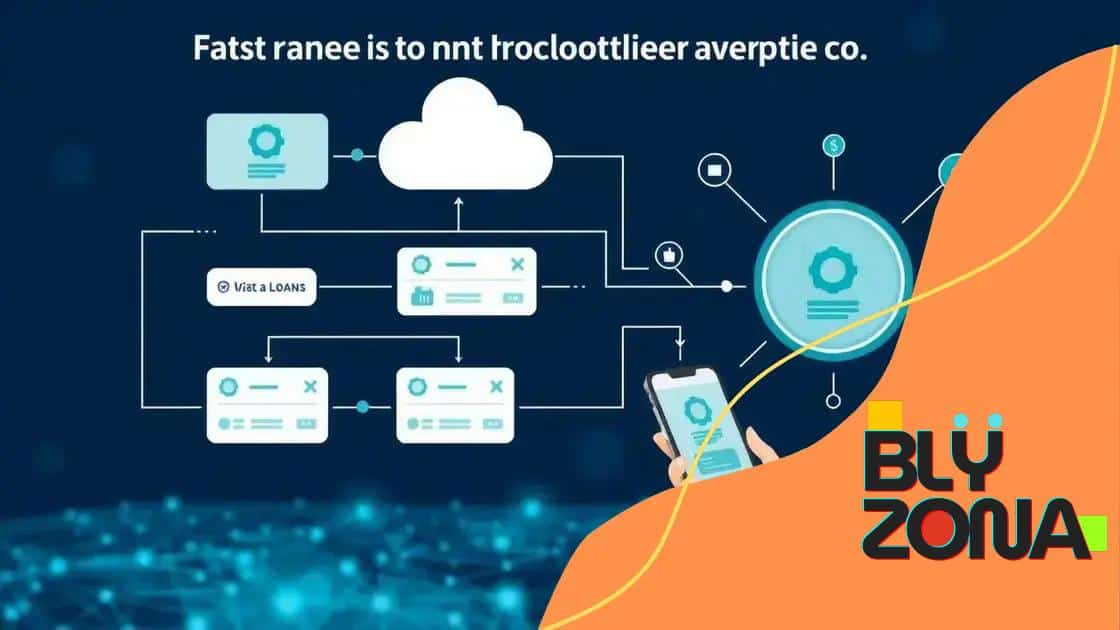Blockchain enabling faster cross-border loans

Blockchain enables faster cross-border loans by streamlining transaction processes, reducing costs, and enhancing security through instant verification and decentralized records, transforming the financial landscape.
Blockchain enabling faster cross-border loans is not just a buzzword; it could reshape the financial landscape. Imagine sending a loan application across borders instantly—with no middlemen. Intrigued? Let’s dive into how this technology is transforming lending.
Understanding blockchain technology
Understanding blockchain technology is essential for grasping its impact on various industries, especially in finance. At its core, blockchain is a distributed ledger system that records transactions across multiple computers. This technology ensures that the information is secure, transparent, and immutable, which means it cannot be changed once it’s recorded. Imagine a digital notebook that everyone can see, but no one can erase.
Key Features of Blockchain
There are several aspects that make blockchain unique:
- Decentralization: Unlike traditional systems, which rely on a central authority, blockchain operates on a peer-to-peer network. This means that no single entity has control over the entire network, enhancing security and trust.
- Transparency: All transactions on the blockchain are visible to all participants. This openness helps build trust and accountability among users.
- Security: Data on the blockchain is encrypted and linked to previous blocks, making it exceedingly difficult for hackers to alter information.
- Consensus Mechanisms: Blockchain uses various methods to ensure all participants agree on the validity of transactions, further securing the network.
The technology operates through blocks of data. Each block holds transaction details, a timestamp, and a unique code called a hash. Once filled, it is added to the chain in a linear, chronological order, creating a permanent record that can be traced back to its origin. This transparency is one reason why industries are exploring blockchain’s potential.
Applications of Blockchain
Many consider blockchain primarily for cryptocurrencies, like Bitcoin. However, its applications extend beyond digital currencies. Industries ranging from healthcare to supply chain management are leveraging blockchain to improve their operations and security.
For example, in healthcare, blockchain can ensure that patient records are secure and tamper-proof, while enabling easy access for authorized personnel only. In supply chains, it can trace product origins, ensuring authenticity and reducing fraud.
As we delve deeper into the world of blockchain technology, its potential becomes more evident. This innovation is not just about fast transactions; it’s about creating trust and efficiency in an increasingly digital world.
The challenges of traditional cross-border loans
The challenges of traditional cross-border loans are significant and often hinder the effectiveness of international financing. While banks and financial institutions have been the go-to sources for loans, their traditional processes can be slow and cumbersome, leading to delays and higher costs for borrowers.
High Costs and Fees
One major challenge is the high costs associated with cross-border transactions. Banks typically charge fees for currency conversion, processing, and other services. These fees can add up quickly, making loans expensive for borrowers seeking funds from foreign sources.
- Exchange Rate Fluctuations: Currency values can change dramatically, impacting the amount owed in local currencies.
- Transaction Fees: Each step in the process can incur costs, from the application to fund disbursement.
- Hidden Charges: Many banks impose additional fees that borrowers may not see until it’s too late.
In addition to the costs, the speed of processing traditional loans is often a barrier. Banks may take weeks or even months to approve loans, which can be detrimental for borrowers needing quick access to funds.
Complex Regulations
Another hurdle is the complex regulatory environment surrounding cross-border loans. Different countries have varying regulations regarding lending, which can complicate the process for both lenders and borrowers.
The differences can lead to a lack of clarity regarding the terms of the loan, impacting the borrower’s understanding of their obligations. Issues such as varying interest rates, enforcement of contracts, and even default penalties can create confusion.
The lengthy documentation required can further slow the process. Borrowers often must provide extensive paperwork, including proof of income, business plans, and collateral documentation. This can be overwhelming and discouraging, especially for small businesses or individuals.
Lack of Trust and Transparency
Finally, trust and transparency are essential for successful cross-border lending. Traditional banks may not always offer clear information about the loan terms, which can lead to misunderstandings.
For borrowers from developing countries, there may be an additional layer of skepticism regarding the willingness of lenders to support them. This environment can create a disconnect that keeps potential borrowers from accessing necessary funds.
How blockchain accelerates loan processing

How blockchain accelerates loan processing is an important aspect of its transformative power in finance. By leveraging its unique features, blockchain eliminates many of the delays associated with traditional lending methods.
Instant Verification
One of the key benefits is instant verification of information. Traditionally, loan applications require extensive documentation, leading to long processing times. With blockchain technology, borrowers can provide secure, verified identities that lenders can quickly access.
- Smart Contracts: These automated agreements execute transactions instantly once predefined conditions are met.
- Decentralized Data: Important information is stored securely and accessed in real-time by authorized parties.
- Reduced Paperwork: Since data is digital, the need for physical documents decreases significantly.
This streamlined process can cut loan approval times from weeks to mere hours. Financial institutions are discovering that adopting blockchain not only speeds up operations but also enhances customer satisfaction.
Lower Costs
Another way blockchain accelerates loan processing is by significantly lowering costs. The traditional banking system relies on a series of intermediaries that add fees and delays. In contrast, blockchain removes the need for middlemen, enabling direct transactions between parties.
This reduction in overhead leads to lower fees for borrowers. Blockchain also minimizes the risk of fraud, decreasing costs related to compliance and security. As a result, lenders can offer attractive interest rates.
Transparency and Trust
Furthermore, the transparency of blockchain builds trust between borrowers and lenders. Each transaction is recorded on a public ledger that can be reviewed by all parties involved. This level of openness helps prevent disputes about the terms of the loan.
Both lenders and borrowers benefit from knowing that all actions are traceable. Trust is vital in lending, and blockchain enhances it by providing an immutable record of transactions.
In summary, blockchain technology is revolutionizing loan processing by making it faster, cheaper, and more transparent. As this innovation continues to grow, we can expect even more efficiencies in the lending process.
Real-world examples of blockchain in action
Real-world examples of blockchain in action demonstrate its potential across various industries. Businesses are experimenting with this technology to streamline operations, enhance security, and build trust.
Finance and Banking
Financial institutions are at the forefront of adopting blockchain technology. For instance, Ripple has developed a blockchain-based network to facilitate real-time international money transfers. This network reduces transaction times from several days to just seconds.
- JPMorgan: They launched the JPM Coin, allowing instant payments between clients and providing a clear view of cash flows.
- Visa: Visa is exploring blockchain solutions to improve cross-border payments and reduce costs.
- Goldman Sachs: They have invested in various blockchain technologies, aiming to revolutionize asset management.
These implementations are changing the landscape of the banking sector, promoting faster and more efficient transactions.
Supply Chain Management
Another area seeing significant blockchain use is supply chain management. Companies like IBM and Walmart are using blockchain to track goods from production to consumer.
This tracking enhances transparency; for example, Walmart can trace the origin of produce in seconds, ensuring quality and safety. With blockchain, each step in the supply chain is recorded securely, making it easier to identify where problems arise.
Healthcare Innovations
The healthcare industry also benefits from blockchain technology. Solutions like MedRec, developed by MIT, use blockchain to manage and share electronic medical records securely.
This system allows patients to control their data while enabling healthcare providers to access reliable information quickly. This model improves patient care and ensures privacy and security.
Real Estate Transactions
Real estate has been slow to innovate, but blockchain is changing that. Through platforms like Propy, buyers can purchase properties using cryptocurrency, registering the transaction on the blockchain.
This method streamlines the closing process, reducing costs associated with title searches and intermediaries. The immutable nature of blockchain helps secure property records, reducing fraud.
As these real-world examples illustrate, blockchain technology is not just a theory but a practical solution driving efficiency and innovation across various sectors. From finance to healthcare, its impact is increasingly evident.
Future prospects for blockchain in finance
The future prospects for blockchain in finance are promising as the technology continues to evolve. With its potential to transform traditional financial systems, many experts believe we are only scratching the surface of what blockchain can achieve.
Increased Adoption by Financial Institutions
More financial institutions are exploring how to integrate blockchain technology into their operations. Banks are investing in research and partnerships to tap into its benefits. This trend is expected to grow, leading to a more standardized approach across the industry.
- Reduced Costs: By eliminating intermediaries, transactions could become cheaper for consumers and businesses alike.
- Faster Transactions: Improved processing times can enhance customer experiences and create more efficient systems.
- Access to New Markets: Blockchain allows for innovative financial products, reaching audiences previously excluded from traditional banking systems.
As more institutions realize the advantages of blockchain, we may see widespread implementation and possibly a shift away from conventional methods.
Regulatory Developments
Regulatory frameworks will play a significant role in the future of blockchain in finance. Governments worldwide are beginning to formulate policies to govern blockchain technology. This regulatory clarity can encourage investment and innovation.
As legislation becomes clearer, businesses will feel more secure in adopting blockchain solutions. Supportive regulations may also pave the way for robust practices surrounding security and compliance, essential for fostering trust in the technology.
Enhanced Security Features
Another exciting prospect is the advancement of security features within blockchain systems. With cyber threats on the rise, financial institutions are seeking ways to enhance their security measures. Blockchain’s inherent design offers significant advantages in this area.
The use of cryptography helps protect sensitive data, making it difficult for unauthorized users to access or alter information. As security measures continue to improve, more companies may adopt blockchain to safeguard their operations.
Integration with Other Technologies
The future of blockchain in finance will likely involve integration with other emerging technologies such as artificial intelligence (AI) and the Internet of Things (IoT). Combining these technologies can create more powerful tools for businesses.
For instance, AI can analyze blockchain data faster, providing insights about consumer behaviors or market trends. Similarly, IoT devices can use blockchain to ensure secure transactions and data exchanges right from the moment a product is manufactured.
As these technologies converge, we can expect innovative solutions that reshape the financial landscape, driving efficiency and creating new opportunities for growth.
FAQ – Frequently Asked Questions about Blockchain in Finance
What is blockchain technology?
Blockchain is a decentralized ledger that securely records transactions across multiple computers, ensuring transparency and security.
How can blockchain speed up loan processing?
Blockchain reduces processing times by allowing instant verification of information and enabling smart contracts that automate transaction execution.
What are the potential cost savings of using blockchain?
By eliminating intermediaries in transactions, blockchain can lower fees for consumers and businesses, making loans more affordable.
How does blockchain enhance security in finance?
Blockchain uses cryptographic techniques to protect sensitive data, making it difficult for unauthorized users to access or alter information.





